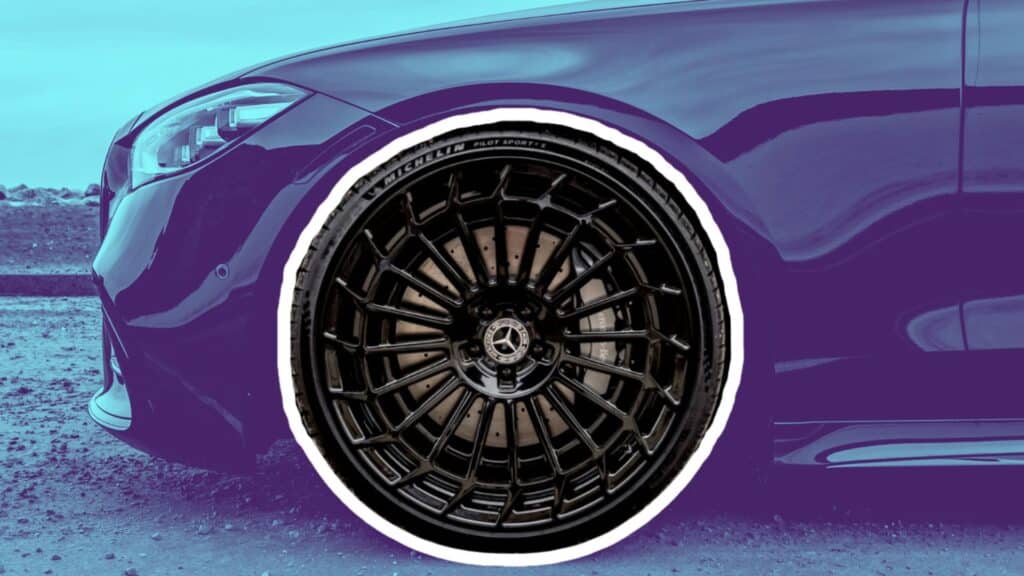When changing wheels, Mercedes Benz owners often face a problem: figuring out bolt patterns.
This small but key detail can greatly affect wheel upgrades, and many drivers find the numbers and measurements puzzling.
We’re here to help explain bolt patterns in simple terms. This guide will show you all you need about Mercedes Benz bolt patterns.
We’ll cover their meaning, importance, and how to find the right one for your car. After reading this, you’ll feel confident about picking new wheels for your Mercedes.
We’ll go over common patterns, how to measure yours, and advice for choosing the right wheels. Let’s explore this vital part of your vehicle together.
What is a Mercedes-Benz Bolt Pattern?
A Mercedes-Benz bolt pattern is a set of numbers that tell you how to fit wheels on your car. It comprises two parts: the number of bolt holes and how far apart they are.
Most Mercedes cars use a pattern with five holes. The space between these holes forms a circle. We measure the size of this circle to get the second part of the pattern.
For example, you might see “5×112” for many Mercedes models. This means there are 5 bolt holes, and the circle they form is 112 millimeters across.
Let’s break down some words you might hear when talking about bolt patterns:
- Center bore: The big hole in the middle of the wheel. It needs to match your car’s hub size.
- Thread size: How thick the bolts are and how close their spirals are. This affects which bolts you can use.
- Offset: How far in or out the wheel sits from the car’s body. It changes how your car looks and handles.
Knowing these terms helps you pick the right wheels for your Mercedes. It also keeps your car safe and working well.
Common Mercedes-Benz Bolt Patterns

Most Mercedes-Benz cars use the same bolt pattern. This makes it easier to find wheels that fit.
The 5×112 pattern is the most common. It’s found on many models, including the A-Class, C-Class, E-Class, S-Class, CLA, CLS, and GLA models.
This pattern means the wheel has five bolt holes in a circle 112 millimeters across.
Some Mercedes cars use a different pattern. The G-Class (also known as G-Wagon) and some Sprinter vans use a 5×130 pattern.
This pattern is less common but still easy to find wheels for. A few other models have unique patterns.
The Citan van uses a 4×100 pattern, while the X-Class pickup truck has a 6×114.3 pattern.
Knowing your car’s pattern helps when you want to change wheels. Most Mercedes cars use the same pattern, but checking your specific model is always good.
Remember, even if the pattern matches, other factors like wheel size and offset are also important for a proper fit.
Why the Mercedes-Benz Bolt Pattern Matters
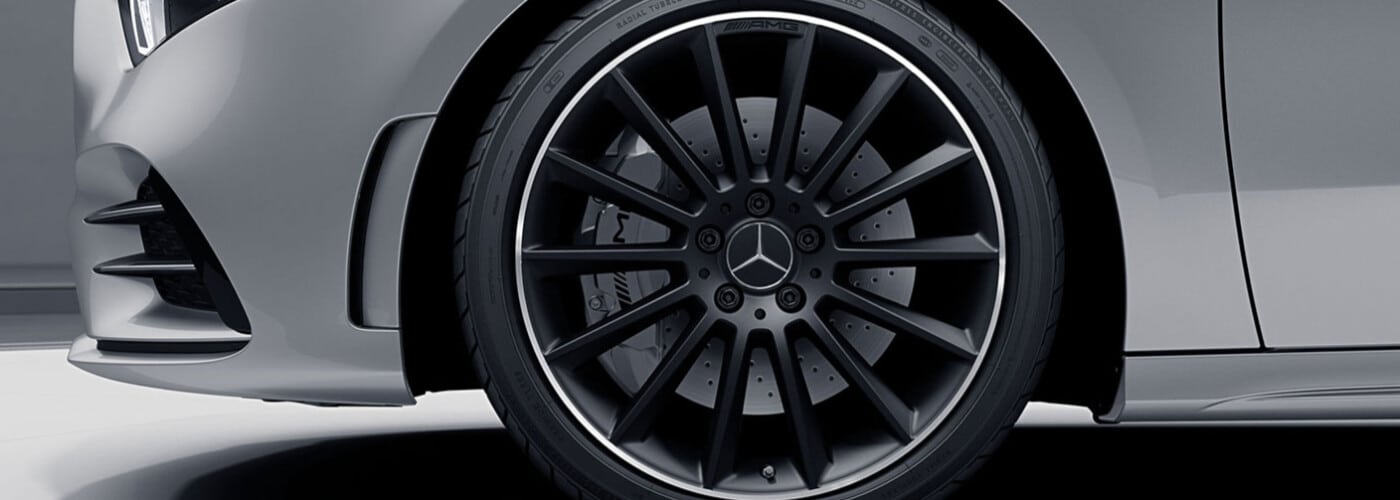
Understanding why the Mercedes-Benz bolt pattern matters is key for any car owner. This small detail plays a big role in your car’s safety, performance, and style.
Let’s examine how the right bolt pattern keeps your Mercedes running smoothly and looking great.
- Safety First: The bolt pattern on your Mercedes-Benz is crucial for safety. When you use the right pattern, wheels fit securely on your car. This means they won’t come loose while driving, reducing the risk of accidents. A proper fit keeps you and others safe on the road.
- Better Performance: A correct bolt pattern helps your car perform at its best. When the wheels fit right, your brakes, steering, and suspension work as they should, leading to a smoother ride and better handling. You’ll feel the difference every time you drive.
- Looks and Feel: The bolt pattern affects your car’s appearance and how it drives. It also determines which wheels you can use on your Mercedes. Some wheels can make your car look sportier, while others give it a more graceful look. The right wheels can also change your car’s feelings, making it more responsive or softer.
- Avoiding Problems: Using the wrong bolt pattern can cause issues. Your car might not handle well, or the wheels could rub against other parts. This can damage your vehicle and make it unsafe to drive. By using the right pattern, you keep your Mercedes looking good and working well for years to come.
Measuring the Mercedes-Benz Bolt Pattern
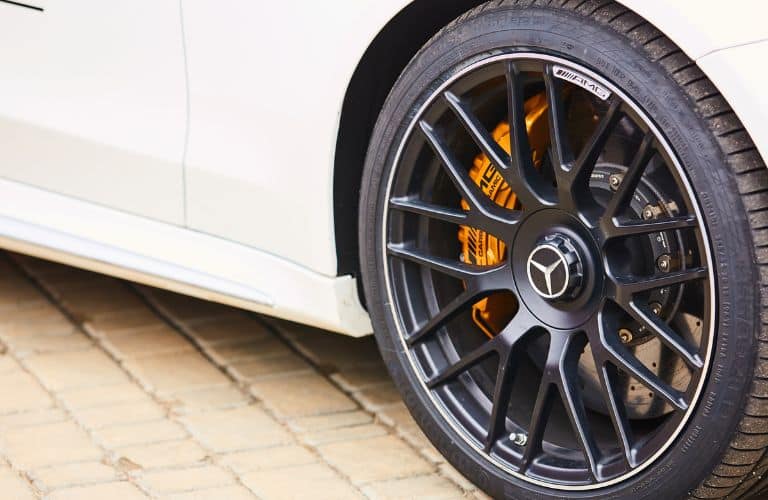
Knowing how to measure your Mercedes-Benz bolt pattern can save you time and trouble buying new wheels.
It’s a simple task you can do at home with just a few tools. Let’s walk through the process step by step.
1. What You’ll Need
To note your findings, you will need only a ruler or tape measure, a piece of paper, and a pencil.
2. Counting Bolt Holes
Start by counting the bolt holes on your wheel. Most Mercedes cars have five.
3. Measuring Five-Bolt Patterns
For five-bolt patterns, find the center of any bolt hole, then measure to the center of the second bolt hole over (not the one right next to it). This gives you the bolt circle diameter.
4. Measuring Four-Bolt Patterns
If your car has a four-bolt pattern, measure from the center of one bolt hole straight across to the center of the opposite hole.
5. Recording Your Measurements
Write down your measurements, noting the number of bolts and the distance you measured. If you measured in inches, multiply by 25.4 to get millimeters.
Remember, accuracy is key. Even a small error can lead to fitting issues. If you’re unsure, it’s always best to double-check or ask a professional for help.
With the right measurements, you’ll be ready to find the perfect wheels for your Mercedes.
Detailed Mercedes-Benz Bolt Pattern Specifications
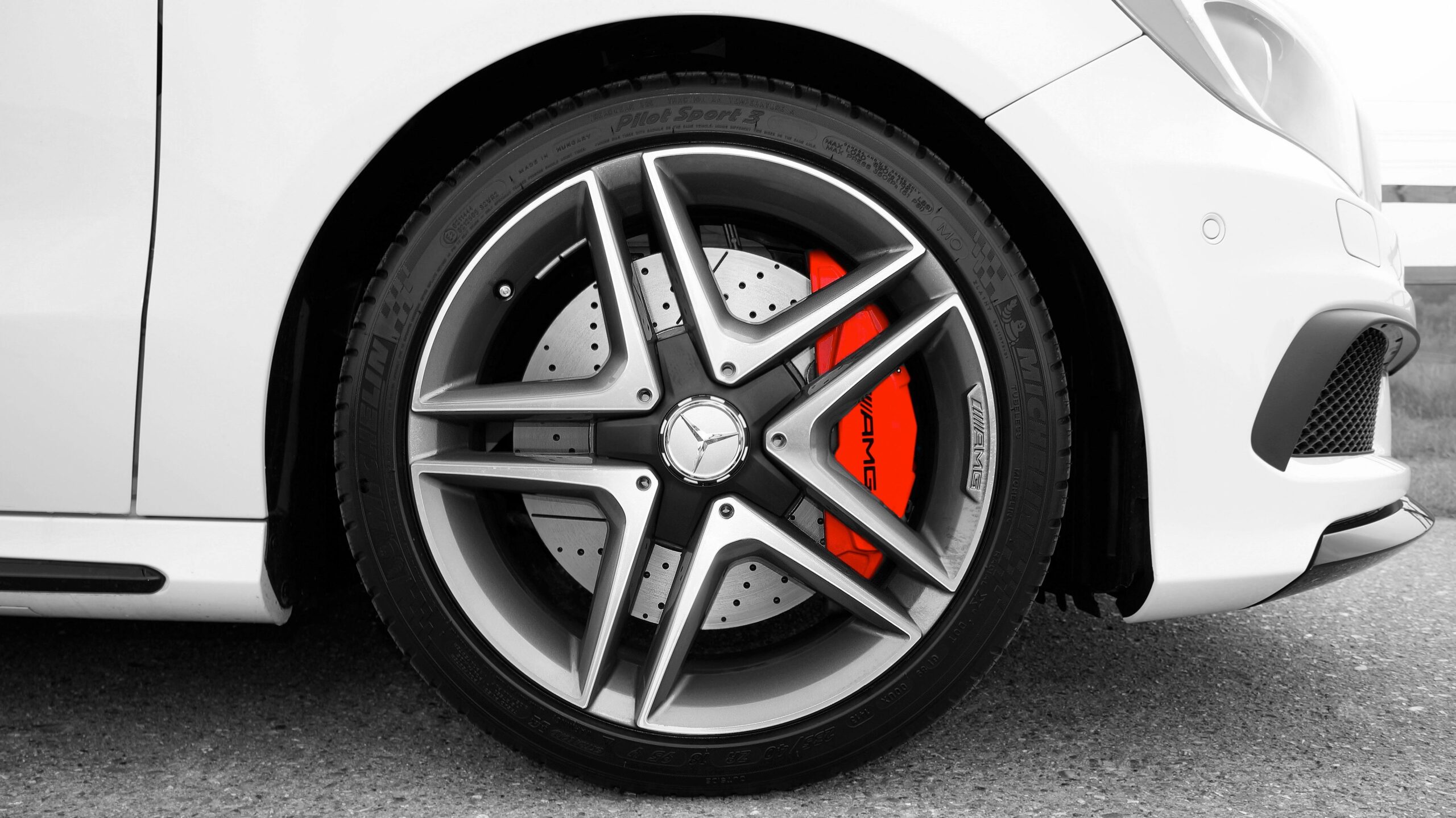
Understanding your Mercedes-Benz’s exact bolt pattern is key when changing wheels. Let’s explore the patterns for different models and their specific details.
1. Common Bolt Patterns
Most Mercedes cars use a 5×112 bolt pattern, which means they have 5 bolts in a circle with a 112mm diameter.
This pattern is common across many models, including the A-Class, C-Class, E-Class, and S-Class.
Along with the bolt pattern, most Mercedes models share a center bore of 66.6mm and a thread size of M14x1.5.
2. Popular Model Specifications
Let’s look closer at some popular models. From 2007 to now, the C-Class uses the 5×112 pattern with a 66.6mm center bore and M14x1.5 thread size.
The wheel torque for this model is typically 130 Nm. The E-Class and S-Class from recent years follow similar specifications, though wheel torque can vary.
3. Special Cases
Some Mercedes models stand out with different bolt patterns. From 1979 to the present, the G-Class uses a 5×130 bolt pattern.
It has a larger center bore of 84.1mm but keeps the M14x1.5 thread size. Sprinter vans also use this 5×130 pattern, making them unique in the Mercedes lineup.
4. Wheel Torque Considerations
Wheel torque is another important factor. While many models use similar torque settings, AMG models often need higher torque.
These high-performance cars might require 150-180 Nm, reflecting their powerful engines and performance needs.
Remember, while this guide covers many models, it’s always best to check your car’s manual or consult a professional.
This ensures you fit your specific Mercedes-Benz model and year perfectly. Proper fit is crucial for safety and performance, so taking the time to get it right is well worth the effort.
Compatibility Concerns with Mercedes-Benz Bolt Patterns
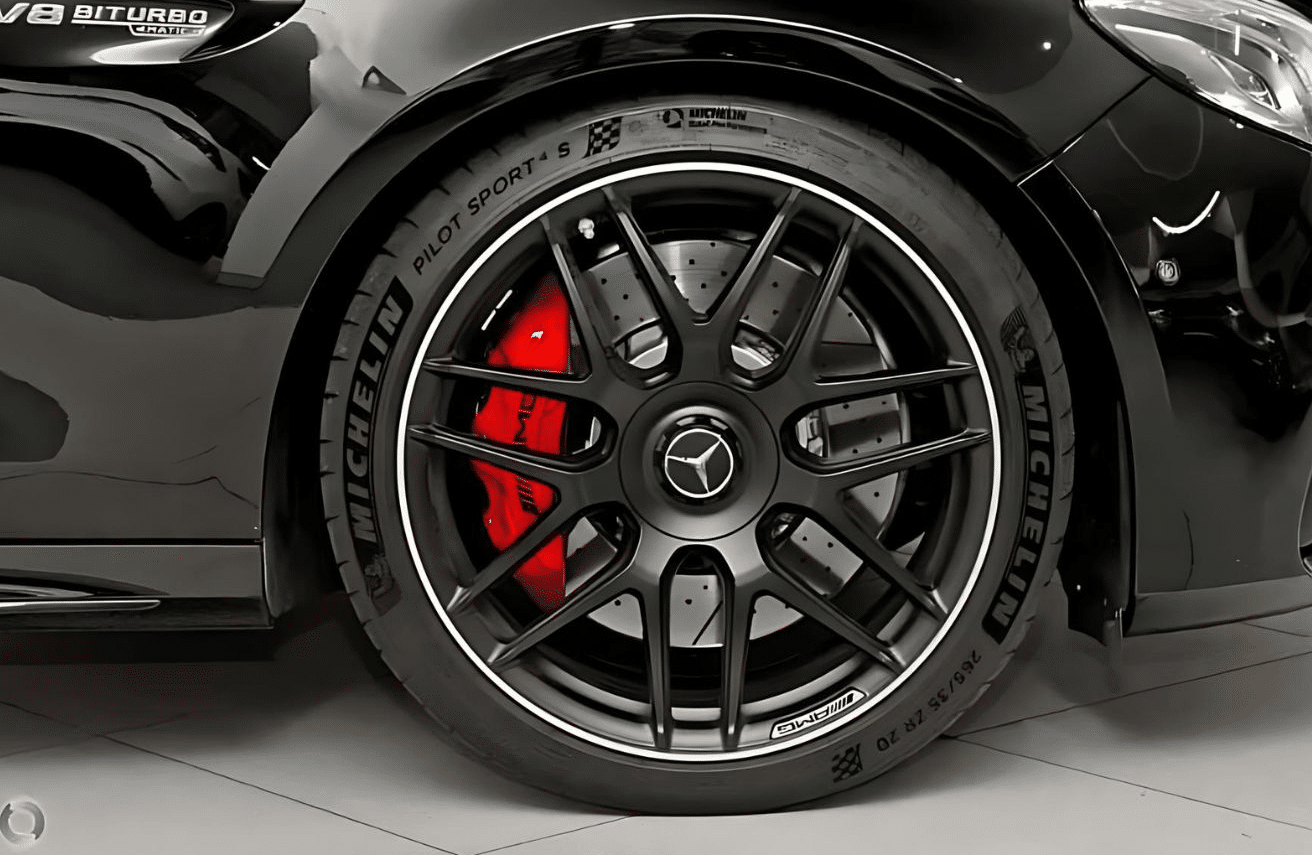
When looking at new wheels for your Mercedes-Benz, you might wonder if wheels from other car brands will fit. Let’s explore this topic and consider some options for using different wheels.
Interchangeability with Other Brands
Many car owners ask if BMW wheels fit Mercedes cars. The short answer is no; they usually don’t. Here’s why:
Mercedes-Benz typically uses a 5x112mm bolt pattern, while BMW often uses a 5x120mm pattern.
This difference means the wheels won’t line up correctly. Also, the center bore sizes are different. Mercedes usually has a 66.6mm center bore, while BMW’s is often 72.6mm.
Other brands might have wheels that fit, but it’s rare. Always check the exact specifications before using wheels from another brand on your Mercedes.
Using Adapters
Adapters might be an option for using wheels with a different bolt pattern. Adapters are metal spacers that change the bolt pattern of your car to match different wheels. Here are some key points about using adapters:
- Safety: Adapters can be safe if they’re high-quality and installed correctly. However, they do add complexity to your wheel setup.
- Performance: Adapters can affect your car’s handling. They move the wheels out slightly, which can change how your car drives.
- Legal issues: Using adapters might not be legal in some areas. Check your local laws before using them.
- Professional help: If you decide to use adapters, have them installed by a professional. Proper installation is crucial for safety.
Remember, while adapters can let you use different wheels, they’re not always the best choice.
It’s often better to find wheels that fit your Mercedes without adapters. This ensures the best performance and safety for your car.
Conclusion
Understanding the Mercedes Benz bolt pattern is key to maintaining your car’s safety and style. We’ve covered bolt patterns, why they matter, and how to measure them.
We’ve also examined common patterns for Mercedes models and discussed compatibility issues.
Remember, the right bolt pattern ensures your wheels fit perfectly, keeping you safe on the road. It also affects your car’s look and performance.
While adapters can help fit different wheels, sticking with wheels made for your Mercedes is usually best.
If you’re unsure about your car’s bolt pattern or need help choosing new wheels, don’t hesitate to ask a professional.
They can guide you to the best choice for your specific Mercedes model. With this knowledge, you can make informed decisions about your Mercedes wheels.
Frequently Asked Questions (FAQs)
What Lug Pattern Is Mercedes-Benz?
Most Mercedes-Benz cars use a 5×112 bolt pattern, which means 5 lug holes in a circle with a 112mm diameter.
What Cars Are 5×112 Bolt Pattern?
Many cars use the 5×112 pattern, including most Mercedes-Benz models, many Audi and Volkswagen cars, and some Chrysler vehicles.
Is 5×112 the Same as 5×120?
No, 5×112 and 5×120 are different bolt patterns. The numbers show the circle diameter (112mm vs 120mm). These patterns are not interchangeable without adapters.

